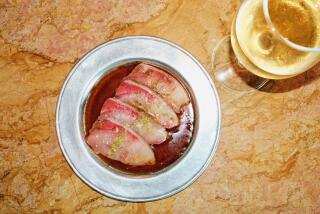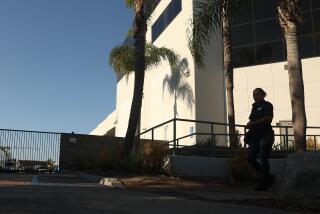It’s the Pits, Say Barbecue Owners of AQMD Action : Pollution: Panel tells rib joints to clean up smoke or alter cooking style. Their fate is in the hands of engineers.
Back in 1980 and 1981, Robert Thomas owned two barbecue restaurants in Sacramento.
In one rib joint, he built a brick pit. He filled the firebox with hickory and oak, and smoked chicken, pork and beef the traditional way.
In the other, he was forced by space constraints to use a pressure cooker. The results were “tender,” he recalled recently. “But I was catering basically to a white population.”
Many blacks patronized the pit restaurant, he said. But when they sampled the wares at the other, they got as steamed as the meat.
Thomas, who is black, learned his lesson. The place he now owns in Gardena is dominated by a glowing pit.
The way he sees it, however, he may be forced to abandon the purity of his ethnic cuisine once again--this time because of the smog.
He and other pit barbecuers say that changing the time-honored way they cook ribs would discriminate against black culture, akin to forcing Japanese cooks to broil sushi or Italians to microwave their pasta.
For now, the future of pit barbecues in Los Angeles is in the hands of a team of engineers. The problem: There is no known way to control the pollutants in the smoke pouring forth from about 50 rib joints in the region, home to the nation’s filthiest air. The temperatures and the grease quotient rise too high for conventional charbroiler filter systems.
Thomas, and several of his competitors, found out the hard way. Prompted by citations from the South Coast Air Quality Management District, they spent tens of thousands of dollars for pollution control equipment that within months caught fire and stopped functioning. They then faced more penalties.
When repeated crackdowns on barbecue pits drew protests from prominent black politicians, AQMD called a truce more than a year ago. With some financial help from Southern California Edison Co., the air quality agency hired a consulting firm for $125,000 to find a solution. During the search, regulators promised, inspectors would not write tickets.
Air quality regulators say the uproar has made them sensitive to a new issue in the intense politics of the fight to clean the air. As state Sen. Diane Watson (D-Los Angeles) puts it: “If we are going to have this kind of diverse society, we have to decide if we are going to protect certain cultural practices.”
If the engineers can come up with effective, affordable technology, all will be well. Their deadline is July.
If they cannot, the alternative for barbecue chefs will be, as the bureaucrats say, to change their process.
Put simply, that would mean an end to wood fires, a prospect that fills pit barbecue owners and aficionados of their cooking with dread.
“Come on,” Watson said. “I’d steam my vegetables, but I wouldn’t want my barbecue steamed, no way.”
“You can’t change it,” said an alarmed Air Force Tech. Sgt. Vincent Crews, who frequents Robert Thomas’ restaurant. “It won’t be the same. Smoke is the whole point.”
Air regulators say not to worry. “I’m very hopeful,” said Alex Bailey, an AQMD engineer, “that this process will move along and we won’t have to touch the cooking process.”
The pit owners, however, are nervous. “AQMD. That word gives me nightmares,” said Leo Carter, who with his wife, Dorothy, owns Leo’s Bar-B-Cue in the Crenshaw district of Los Angeles. “You can’t sleep nights, worrying about those folks.”
Assemblywoman Gwen Moore (D-Los Angeles) said it is “crazy that they’re even going to all this trouble. For 50 little companies. Just think of how much money and how much time is going into doing this. It’s regulation for regulation’s sake, with no real impact.”
Indeed, AQMD is not sure how much pollution the barbecue spots contribute to the air in its jurisdiction of Los Angeles, Orange, Riverside and San Bernardino counties. But “the thinking is that there will be one rule that covers emissions from restaurants and since these are restaurants, they will be covered,” said AQMD spokesman Bill Kelly.
A restaurant regulation is scheduled to come before the AQMD board in October, Kelly said. Eateries are not eligible for the proposed trading market in emissions rights under a plan envisioned by the AQMD’s staff.
For barbecue cognoscenti around the country, the uproar provides a welcome excuse to revive some long-simmering debates. Does barbecue have to be cooked over a wood fire? And is it ethnic cooking or regional food?
Bobby Seale, a Black Panthers co-founder who has written a barbecue cookbook, cooks over charcoal briquettes and uses hickory chips and liquid smoke for seasoning. His meat, he has contended, tastes authentic.
But his words triggered cries of heresy.
“If it ain’t smoked, it ain’t barbecue. It’s just that simple,” said John Egerton, a Nashville-based author who writes about Southern food, culture and race relations.
In the South, the barbecue is the equivalent of a bakery in the Midwest, a staple on every town’s main street. As blacks migrated from the South to Chicago, Kansas City and Los Angeles after World War II, the transplants flocked to eateries that sprang up in their new neighborhoods dispensing the familiar smoke-seared meat basted with tangy sauce.
‘It was a natural. Barbecue is relatively inexpensive, it’s something that small entrepreneurs can do, and the smoke is the best and cheapest form of advertising,” said Charles Stewart, a Watson aide. “It draws you right in.”
Even Alan Phillips, the white owner of Harry’s Open Pit Barbecue in Hollywood, where kosher hot dogs and skinless chicken breast augment the traditional hot links and ribs, said that smoked barbecue is “definitely a cultural thing, no doubt about it.”
His late father--the eponymous Harry--operated 14 barbecue restaurants in Los Angeles, 13 of them in predominantly black neighborhoods. Both the senior and junior Phillips learned their barbecue skills, said the son, “from a black person, Pat Nails. The sauce was an 80-year-old recipe. It came from the South Side of Chicago.”
A blown-up photo of Harry, flanked by black boxing greats Joe Louis and Sonny Liston, is posted over Phillips’ front counter. Oak logs are piled in two corners. “Pretty close to 50% of my customers are black people,” Alan Phillips said.
But when it comes to defining pit barbecue as black, others demur. “It depends where you are,” said writer Calvin Trillin, who has waxed poetic in print about the burned rib tips at Arthur Bryant’s in his hometown, Kansas City, Mo.
“In Kansas City,” Trillin said, “going to a white barbecue place was like going to a Gentile internist. Things might turn out all right, but you haven’t really been playing the percentages.
“But Texas is slightly different. You wouldn’t hesitate to walk into a white barbecue place in Texas.”
Said Egerton: “I would not suggest that nobody white can or ought not to barbecue ribs. I would not call (regulators) racist.
“But you don’t have to be racist to be stupid. This is a dying art. It’s hard work. Anybody who is willing to try it ought to get the thanks of (government officials) instead of the backs of their hands.”
From the AQMD’s point of view, the agency is being more than accommodating. More and more small businesses are being affected by air quality regulations, as AQMD looks harder for ways to cut pollutant pouring into the skies. It is not often that polluters have been allowed to continue operating unimpeded for 1 1/2 years while the agency looks for an easy, inexpensive way to minimize emissions.
The district’s inspectors were pulled off the barbecue pit patrol after legislators complained and “we realized that some of our rules impact segments of the ethnic community and we had to have a special dialogue with these people,” said AQMD public adviser John Dunlap.
Three rib joints were chosen for study, among them Thomas’ Rib Nest, an unprepossessing building at a busy South Bay intersection.
There, the engineering team from Tustin-based Carnot held sway for a week recently. One Carnot employee stood by the brick pit. He took notes every time the kitchen staff opened the firebox door, piled oak onto the blaze or parceled meat onto the oven’s racks.
Outside, an observer watched the color of the smoke emerging from the chimney change from wispy white to opaque gray.
On the roof, the other members of the team adjusted a pair of ladders to move gas probes around in the chimney, while vapors filtered through a cylinder, filled with marbles and stashed in a bucket of ice. Then the fumes continued into a pair of instruments with dizzying arrays of switches and dials.
Project manager Carmela J. Rossi, a former designer of spacecraft systems, recorded temperatures as high as 460 degrees Fahrenheit from the chimney. “There’s a lot more grease than I thought,” she said.
But she said she is confident she can find equipment that keeps the stuff from fouling the air.
“Boy, I hope so,” said Leo Carter, who said he has spent $65,000 in vain attempts to cut pollution from his rib joint. “I’ve made every restaurant show for the last 20 years looking for something that will do the job. We tried from Maine to Minnesota. I’ve spent all I could spend.”
More to Read
Inside the business of entertainment
The Wide Shot brings you news, analysis and insights on everything from streaming wars to production — and what it all means for the future.
You may occasionally receive promotional content from the Los Angeles Times.










